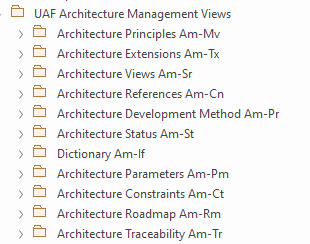| Prev | Next |
UAF Architecture Management Views
The Architecture Management viewpoint, introduced in UAF 1.2, focuses on how architecture initiatives are governed and coordinated. It encompasses a set of views that include both formal architecture products and reports, along with recommended practices contributed by the UAF specification team. As part of the Unified Architecture Framework Specification Version 1.2, this viewpoint is one of the key perspectives supporting the overall framework. Its emphasis is not on the technical content of architectures, but rather on the processes, methods, and practices for managing them. It provides stakeholders with practical guidance for structuring architecture activities, monitoring progress, and ensuring that outcomes remain aligned with organizational goals and established standards.

UAF Architecture Management Views
|
Architecture Principles Am-Mv |
Stakeholders: Enterprise Architects, Enterprise Systems Engineers, Model Managers, System Architects. Concerns: alignment of architecture with architecture heuristics, guidelines, and principles. Definition: identifies relevant architectural principles and other guidelines to be used in architecture development and evaluation. |
|
Architecture Views Am-Sr |
Stakeholders: Enterprise Architects, Model Managers, Modelers, Technical Managers. Concerns: Domains, viewpoints, aspects, model kinds, and view specifications that are used to describe the architecture. Definition: (i) Lists predefined and custom domains, model kinds, viewpoints, aspects, and view specifications (ii) and identify the key stakeholders and their perspectives and concerns. |
|
Architecture References Am-Cn |
Stakeholders: Enterprise Architects, Model Managers, Modelers, Enterprise Systems Engineers. Concerns: Development sequence of models and views and how they are related to each other. Definition: Defines workflow or process steps used in managing the architecture development. |
|
Architecture Development Method Am-Pr |
Stakeholders: Enterprise Architects, Model Managers, Modelers, Enterprise Systems Engineers. Concerns: Development sequence of models and views and how they are related to each other. Definition: Defines workflow or process steps used in managing the architecture development. |
|
Architecture Status Am-St |
Stakeholders: Enterprise Architects, people who want to understand the architecture governance, Technical Managers. Concerns: Architecture status. Definition: Captures version number and approval workflow of the architecture. |
|
Dictionary Am-If |
Stakeholders:Solution Providers, Systems Engineers, Software Architects, Business Architects. Concerns: Provides a central reference for a given architecture’s data and metadata. It enables the set of architecture description to stand alone, with minimal reference to outside resources. Definition: Contains definitions of terms used in the given architecture. It consists of textual definitions in the form of a glossary, their taxonomies, and their metadata (i.e., data about architecture data), including metadata for any custom tailored views. Architects should use standard terms where possible (i.e., terms from existing, approved dictionaries, glossaries, and lexicons). |
|
Architecture Parameters Am-Pm |
Stakeholders: Enterprise Architects, Enterprise Systems Engineers, Model Managers, System Architects. Concerns: Architecture parameters. Definition: Depicts and analyzes measures and measurements that are applicable to management of the architecture. |
|
Architecture Constraints Am-Ct |
Stakeholders: Enterprise Architects, people who want to understand the architecture constraints, Technical Managers. Concerns: Architecture assumptions and constraints. Definition: Depicts and analyzes assumptions, constraints, rules, policy and guidance that are applicable to aspects of the architecture. |
|
Architecture Roadmap Am-Rm |
Stakeholders: Enterprise Architects, people who want to understand the architecture development plan, Technical Managers. Concerns: Architecture release schedule. Definition: Captures project timeline for the architecture. |
|
Architecture Traceability Am-Tr |
Stakeholders: Enterprise Architects, people who want to understand impact of change across the architecture supporting assets, Technical Managers. Concerns: Reuse of architectures. Definition: Shows references to operational, services, and resource architectures, asset libraries, legacy architectures, and external sources, e.g., documents. |